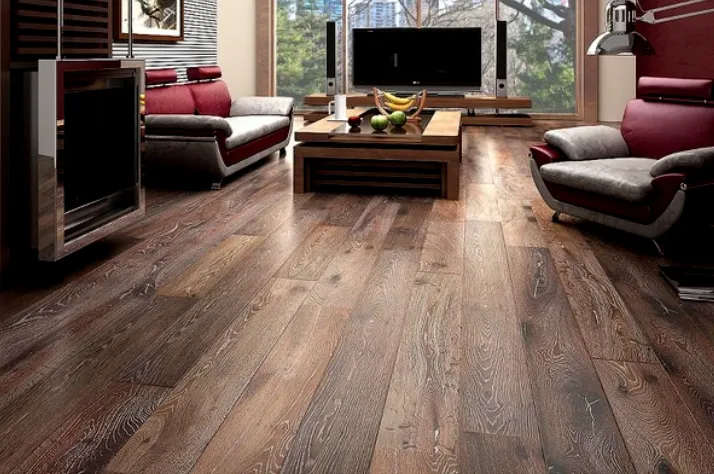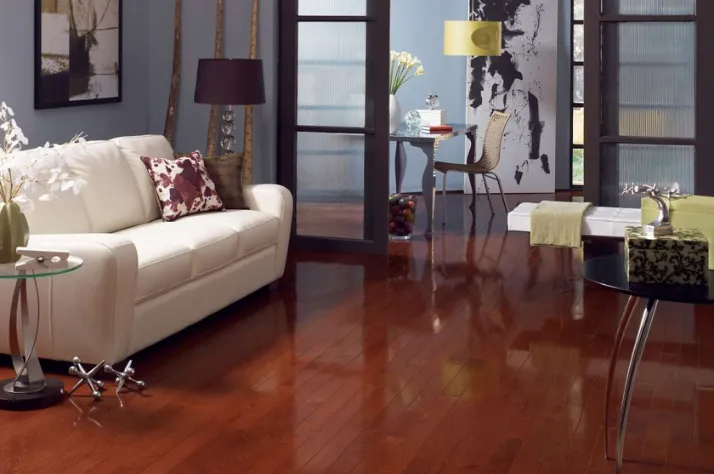Old and torn engineered wood floors look bad. Only refinishing them can bring back their glossy look. But can you refinish them?
Wooden floors are widely recognized because of their appearance, quality, and many other attributes, but not everyone can afford them. It has become numerous options, including solid wood floors, engineered wood floors, etc.
Coming to our question, Yes, you can refinish it but don’t jump into this work without knowing a few factors. A wear layer installed on the top layer of engineered floors tells how many times you can refinish a floor.
I will explain further with a table for your better understanding. Apart from a wear layer, you must acknowledge a few other points. Let’s begin with our guide.
Why Should You Refinish Engineered Wood Floors?
You have got your answer, but the main question is why one needs to refinish it or what circumstances let people refinish the floor. The two common reasons for refinishing the floor are:
- To gain the original shine of the floor that has been lost due to different reasons
- To change the stain color of your floors.
Refinishing grants a glossy touch to the floor, so if the original color has faded and nothing else works, refinish your floors. I did refinish my floors to get the same shine, and it worked.
How Many Times Can You Refinish Engineered Hardwood
As discussed earlier, it depends on the top wear layer of engineered floors. The more thickness it has, the maximum times you can refinish it.
To simplify my words, I have made a table that will give you a clear idea about how many times you can refinish.
| Thickness Level | Number of Refinishes |
| If the layer is 3mm | Refinish it 2 times only |
| If the layer is 4mm | Refinish it 3 times |
| If the layer is 5mm | Refinish it 4 times |
| If the layer is 6mm | Refinish it 5 times |
And the list goes on. The more numbers added to the thickness level, the more times you can refinish it. Two main layers are present on Engineered wood floors, among which one is laid at the bottom while the second is at the top.
The bottom layer is further comprised of numerous layers. The primary purpose is to give strength to the floor planks. This layer also fights against cupping. You are already familiar with the purpose of the top layer.
Other Factors to Consider for Refinishing
Have you planned to refinish your precious engineered floors but don’t know what things you will gain or lose after this process? Preparing yourself with all the information is vital before doing something new.
When I refinished my floors, I did thorough research to avoid being shocked by the results. I have listed a few points that tell the after results of floor finishing. Check them below.
- Once you refinish your engineered floors, you will no longer witness the old texture or finish. Whether you previously had hand-scraping or natural oil finishing, it will no longer be available on the floor because of refinishing. Due to sanding, everything will be gone, and you will get a completely changed look.
- A wire brushing on oak-engineered floors depicts a vintage look, but after refinishing, there won’t be such a thing. Be ready to say goodbye.
- Between the floor plank, a micro bevel or bevel is installed that helps conceal the planks’ smooth parts. After floor sanding, this bevel will be eliminated. Once it is removed, your engineered floors will start looking like solid hardwood floors.
You can commence this process if you are still satisfied with all the above things you will lose after refinishing.
How to Refinish Engineered Wood Floors?
The process is simple, so I will explain it in a few paragraphs. Bring all the required items and try to operate them at home. However, you can call a professional if it seems complicated.
Tools Required
The tools needed for this work are:
- Hand-held orbital sander
- Moist mop
- Floor gloss product
- Vacuum cleaner
- 60-grit paper
- Different sanders
1- Prepare the Floor
The more accurately you prep the floor, the better your floor will be sanded or finished. When you begin finishing, there should not be a single object, including furniture, in the room. There might be a few damaged planks on the floor, so get rid of them before proceeding toward the central step.
Moreover, you can hide wardrobes and windows with paper so they remain tidy. Though with advanced sanding machines, the process no longer remains messy and complicated, it is more reasonable to shield them.
2- Start Sanding the Floor
You need two items in this step: an oblong pad with a 60-grid paper and a hand-held orbital sander.
It is better to have extra pads because the process requires periodic changing of pads. Do not apply a lot of pressure while sanding on the floor because the surface is delicate, as it might harm the floor if you show aggression.
3- Use Different Sanders
While choosing the sander, ensure it looks excellent on your Engineered floors. Different handy machines you can pick in this regard are Disc sanders or heavy-duty belts. These machines help to make the floor clear by uncovering scratches and scuff marks that make repairing process easy.
One of the widely used sanders, Orbital, also known as Finishing sanders, gives a perfect finishing and a smooth look to the floor. Do not over-sand the floor because it will destroy the original look.
4- Remove the Dirt
Pick a good vacuum cleaner and start clearing the dust from the floor. After vacuuming, take a moist mop to clean all the residues. Do thorough cleaning from every corner, so your floor is set for further work. Wait for at least 24 hours to dry the surface.
5- Start Finishing the Floor
I suggest a wood stain product for finishing because it goes well with Engineered floors. Bring a brush and use the product on the floor, starting from one end. Once the entire floor is covered, let it dry.
6- Use a Floor Gloss
The floor with a glossy look seems perfect, so always buy the right floor gloss. Once your floor is dry, apply this gloss product on the entire surface. Again, wait till the surface is dry. You are done.
FAQs – Frequently Asked Questions
Let’s have a quick question-answer session to learn more about Refinish Engineered wood floors.
Can You Refinish Engineered Wood Floors without Sanding?
If you do not want to step into the sanding process, you can still refinish using a chemical abrasion kit, easily available in local stores. Furthermore, you can re-coat or buff the floors using polyurethane. It is possible to refinish the floors without sanding.
What is the Right Way to Change the Color of Wood Floors?
If the current color is dull or you are bored of seeing the same color, the most popular way to change it with another wood floor color is by sanding and finishing. It will overall change the look of your floors. Before sanding, ensure the thickness level of the wear layer as described above.
What is Cost to Refinish Engineered Hardwood Floors
Replacing the wood floors is costly, and refinishing always costs less. You need a few items for finishing purposes; they can be done at home. The labor cost of replacing the entire wooden floor is huge and not within everyone’s reach. For new touch, finishing is always great.
What is the Actual Cost of Refinishing Engineered Floors?
The per-square-foot price is approximately $3 to $8, so to cover the entire room, it will cost almost $300 to $800. If you are refinishing your entire home, the price will be $2,400 to $6,000. It is a rough idea because a few factors increase or decrease the price.
Can You Refinish Distressed Engineered Hardwood?
Yes, it is possible to refinish distressed engineered hardwood. However, it is important to note that the number of times you can refinish engineered hardwood is limited compared to solid hardwood due to the thin veneer layer. Before refinishing, it’s crucial to assess the floor’s condition and determine if it can handle another sanding process.
Can You Sand and Refinish Engineered Hardwood?
You can be careful and first make sure it can handle another sanding process.
Can You Refinish 3/8 Engineered Hardwood?
⅜ engineered hardwood can also be refinished, but it’s important to assess its condition before trying a new sanding.
Refinish Engineered Wood Floors for a Glossy Touch!
Solid and Engineered wood floors are broadly used flooring choices that people often prefer for a tempting look. How hard you try to retain them in their original form, they will get dull after some time, which is why refinishing is essential.
I installed this flooring two years ago and refinished it by following the abovementioned steps. The budget was friendly and didn’t create a lot of inconvenience. Hence, you can also try it to bring some change.
Keep all the details in mind before proceeding with the step. Check the thickness of the wear layer and then refinish according to the conditions. The table will help you to decide how many times you can refinish the floor.


This is such a helpful content. I get a lot of tips and Information. Thank you!